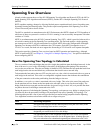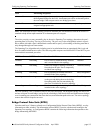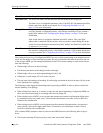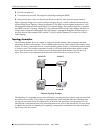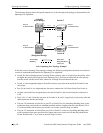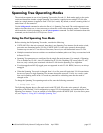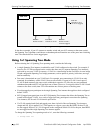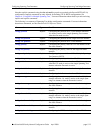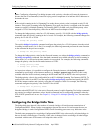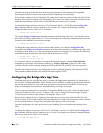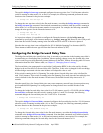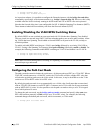
Configuring Spanning Tree Bridge Parameters Configuring Spanning Tree Parameters
page 5-12 OmniSwitch 6600 Family Network Configuration Guide April 2006
Configuring Spanning Tree Bridge Parameters
The Spanning Tree software is active on all switches by default and uses default bridge and port parame-
ter values to calculate a loop free topology. It is only necessary to configure these parameter values to
change how the topology is calculated and maintained.
Note the following when configuring Spanning Tree bridge parameters:
• When a switch is running in the 1x1 Spanning Tree mode, each VLAN is in essence a virtual bridge
with its own Spanning Tree instance and configurable bridge parameters.
• When the switch is running in the flat mode and STP (802.1D) or RSTP (802.1w) is the active proto-
col, bridge parameter values are only configured for the flat mode instance.
• If MSTP (802.1s) is the active protocol, then the priority value is configurable for each Multiple Span-
ning Tree Instance (MSTI). All other parameters, however, are still only configured for the flat mode
instance and are applied across all MSTIs.
• Bridge parameter values for a VLAN instance are not active unless Spanning Tree is enabled on the
VLAN and at least one active port is assigned to the VLAN. Use the vlan stp command to enable or
disable a VLAN Spanning Tree instance.
• If Spanning Tree is disabled on a VLAN, active ports associated with that VLAN are excluded from
Spanning Tree calculations and will remain in a forwarding state.
• Note that when a switch is running in the flat mode, disabling Spanning Tree on VLAN 1 disables the
instance for all VLANs and all active ports are then excluded from any Spanning Tree calculations and
will remain in a forwarding state.
To view current Spanning Tree bridge parameter values, use the show spantree command. For more
information about this command, see the OmniSwitch CLI Reference Guide.
Bridge Configuration Commands Overview
Spanning Tree bridge commands are available in an implicit form and an explicit form. Implicit
commands resemble commands that were previously released with this feature. The type of instance
configured with these commands is determined by the Spanning Tree operating mode that is active at the
time the command is used. For example, if the 1x1 mode is active, the instance number specified with the
command implies a VLAN ID. If the flat mode is active, the single flat mode instance is implied and thus
configured by the command.
Explicit commands introduce three new keywords: cist, 1x1, and msti. Each of these keywords when used
with a bridge command explicitly identify the type of instance that the command will configure. As a
result, explicit commands only configure the type of instance identified by the explicit keyword regardless
of which mode (1x1 or flat) is active.
The cist keyword specifies the Common and Internal Spanning Tree (CIST) instance. The CIST is the
single Spanning Tree flat mode instance that is available on all switches. When using STP or RSTP, the
CIST is also known as instance 1 or bridge 1. When using MSTP (802.1s), the CIST is also known as
instance 0. In either case, an instance number is not required with cist commands, as there is only one
CIST instance.
The 1x1 keyword indicates that the instance number specified with the command is a VLAN ID. The msti
keyword indicates that the instance number specified with the command is an 802.1s Multiple Spanning
Tree Instance (MSTI).



